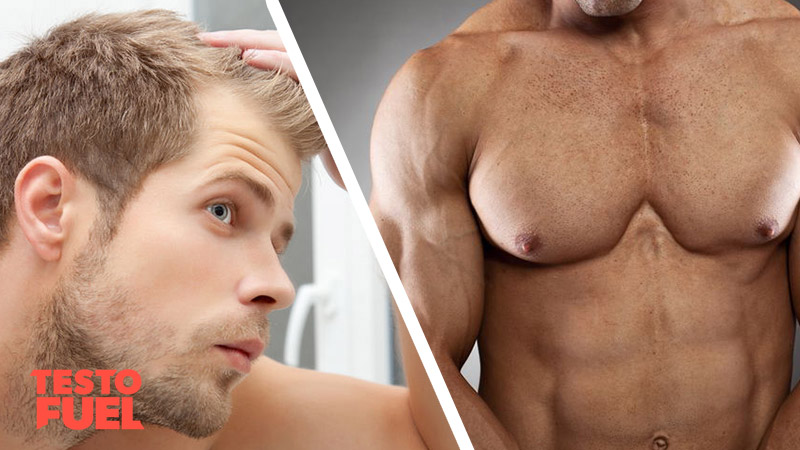TestoFuel Blog : Make Gains & Pack on the Muscle

We all want to look good – have a muscular physique, toned abs and low body fat. Pretty much all of us want to have healthy looking hair too.
For most of us men though, at some point in our lives we will start to lose it – it will gradually get thinner and eventually we’ll begin to see the effects. But for some of us we will start to lose our hair much more prematurely than we’d expect – and that can lead to a lack of confidence, low self-esteem and anxiety.
In this article we’ll take a look at the causes of hair loss and male pattern baldness, and shed some light on whether testosterone levels can affect it. We’ll cover:
Hair loss in males, often referred to as ‘male pattern baldness’ (MPB) or ‘androgenetic alopecia’, effects around 40 million men in the US, or if cohort studies are used as a statistical measure then around 73.5% of men [1].
White men are 4 times more likely to develop MPB than black men – by the age of 30, 30% of white men have hair loss, 50% by 50 years old, and 57% by 60 years old [2].
The rate of hair loss in MPB differs per person, but follows a typical pattern and takes around 15-25 years for complete hair loss to occur.
Generally it starts with receding hair at the sides of the head near the temples in a wedge shaped pattern. As it progresses, thinning of the hair on top of the head, then hair loss towards the crown of the head occurs. Male hair loss can be ‘coded’ using the Norwood scale.
It is not considered a medical problem unless it causes the person social stress, confidence issues, is premature and excessive, or is associated with an irregular pattern.
Hair loss is an inevitable consequence of ageing, however there are two main causes of MPB – genetics and hormones.
Although testosterone is your main male, androgenic hormone, for it to be able to do its job effectively and generate thick hair, it must first be converted into dihydrotestosterone (DHT) – a hormone which is converted by an enzyme called 5-alpha-reductase. It is 5 times stronger than T.
Men that go bald tend to have a genetically higher level of DHT. They also tend to inherit hair follicles that are oversensitive to the hormone too.
As such their hair ‘miniaturizes’ or shrinks, reducing its thickness and then growing potential. Essentially, DHT acts as a barrier within the hair follicle stopping nutrients and growth proteins from attaching to it, so the hair gets thinner and thinner until it is barely visible – so called ‘vellus hair‘.
Hair loss occurs when DHT levels reach a point where it inhibits hair growth and outweighs the body’s ability to stimulate growth cycles in the follicle.
It is now clear that DHT, rather than testosterone is the principal androgen responsible for male pattern hair loss [3].
There is a common misconception that hair loss is due to high levels of testosterone, and that baldness is caused by testosterone somehow having the ability to forcibly ‘throw out’ your hair. In reality practically every study investigating this has found T levels to be about the same – the only difference being the elevated DHT and sensitivity within the follicle.
There are also the old wives’ tales of hair loss being linked to higher levels of T – and that bald men are somewhat men virile. Unfortunately, recent studies have found that bald men appear to be no more virile than their well thatched contemporaries [4].
The genetic information we gather from our parents contributes to hair follicles being over sensitive to DHT, not levels of testosterone itself. If anything, the conversion of T to DHT would mean a high DHT / low T ratio.
This was seen in a study in the journal Experimental and Clinical Endocrinology & Diabetes [5] reported that in 37 men with premature balding – as defined by hair loss before the age of 30 – levels of testosterone were reduced, not elevated.
So ultimately it’s really more about genetics than testosterone levels as to whether you’ll develop male pattern baldness.
This all comes back to genetics again.
When you administer large amounts of steroids – as is the case with androgenic-anabolic steroids such as exogenous testosterone, you invariably get an increase in DHT too (unless you were also taking a 5 alpha-reductase inhibitor as well!). If again you are genetically prone to MPB then this will accelerate your symptoms massively.
However, in those who do not have a genetic pre-disposition for hair loss, it is unlikely that taking steroids will have an effect – there are always exceptions to the rule though, just look at a modern bodybuilding show and you’ll see the odd one or two with full heads of hair.
Male pattern baldness, or androgenetic alopecia, is a common occurrence in men, with over a quarter in their thirties experiencing hair loss, increasing to over half by 50 years old.
Old wives’ tales suggesting that hair loss is due to high levels of testosterone are unfortunately incorrect – as is the premise that baldness increases virility.
Men that suffer hair loss tend to inherit hair follicles that are oversensitive to an offset of testosterone called DHT. For that reason the cause of baldness is more genetically driven as opposed to anything else.
Steroids may accelerate the loss of hair in those that are already sensitive to the effects of DHT due to the massive increase in circulating androgens, however in those that aren’t, there are minimal to no effects.